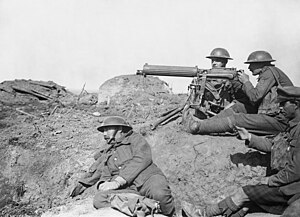This article needs additional citations for verification. (July 2023) |

Technology during World War I (1914–1918) reflected a trend toward industrialism and the application of mass-production methods to weapons and to the technology of warfare in general. This trend began at least fifty years prior to World War I during the American Civil War of 1861–1865,[1] and continued through many smaller conflicts in which soldiers and strategists tested new weapons.

World War I weapons included types standardised and improved over the preceding period, together with some newly developed types using innovative technology and a number of improvised weapons used in trench warfare. Military technology of the time included important innovations in machine guns, grenades, and artillery, along with essentially new weapons such as submarines, poison gas, warplanes and tanks.[2]
The earlier years of the First World War could be characterized as a clash of 20th-century technology with 19th-century military science creating ineffective battles with huge numbers of casualties on both sides. On land, the quick descent into trench warfare came as a surprise, and only in the final year of the war did the major armies make effective steps in revolutionizing matters of command and control and tactics to adapt to the modern battlefield and start to harness the myriad new technologies to effective military purposes. Tactical reorganizations (such as shifting the focus of command from the 100+ man company to the 10+ man squad) went hand-in-hand with armoured cars, the first submachine guns, and automatic rifles that a single individual soldier could carry and use.
- ^
Compare: Boot, Max (19 October 2006). "The Consequences of the Industrial Revolution". War Made New: Weapons, Warriors, and the Making of the Modern World (reprint ed.). New York: Penguin Publishing Group (published 2021). ISBN 9781101216835. Retrieved 2017-01-24.
The First Industrial Revolution transformed warfare between the end of the Crimean War (1856) and the start of World War I (1914)
- ^ Tucker, Spencer C. (1998) The Great War: 1914-18. Bloomington: Indiana University Press; p. 11